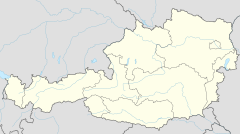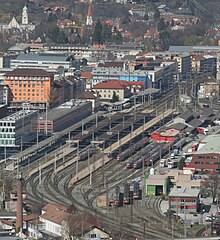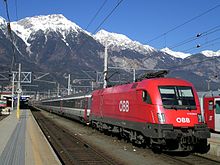
The Austrian Federal Railways, now commonly known as ÖBB, is the national railway company of Austria, and the administrator of Liechtenstein's railways. The ÖBB group is owned entirely by the Republic of Austria, and is divided into several separate businesses that manage the infrastructure and operate passenger and freight services.
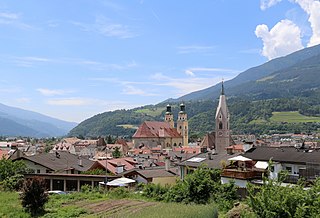
Brixen is a town and commune in South Tyrol, northern Italy, located about 40 kilometres (25 mi) north of Bolzano.

Bologna Centrale is the main railway station in Bologna, Italy. The station is situated at the northern edge of the city centre. It is located at the southern end of the Milan-Bologna high-speed line, which opened on 13 December 2008, and the northern end of three lines between Bologna and Florence: the original Bologna-Florence line through Porretta Terme and Pistoia; the Bologna–Florence Direttissima via Prato, which opened on 22 April 1934 and the Bologna-Florence high-speed line, which opened to traffic on 13 December 2009.

Landeck-Zams railway station, formerly Landeck, is a railway station in the city of Landeck, in the Austrian state of Tyrol. It is located on the Arlberg railway between Innsbruck and Bludenz. It is frequented by more than 2000 travellers a day, whereby a majority of them are commuters that are working or studying in Innsbruck.

St. Anton am Arlberg railway station is a railway station in the village of St Anton am Arlberg in the Austrian state of Tyrol. It is located on the Arlberg railway between Innsbruck and Bludenz. It is located directly between the 10.648 km (6.616 mi) long Arlbergtunnel and the Wolfsgrubentunnel.

Ötztal is a railway station on the Arlberg railway between Innsbruck and Bludenz in Tyrol, Austria. In Ötztal the second track coming from Innsbruck ends and the Arlberg line continues as a single-track railway till Landeck.
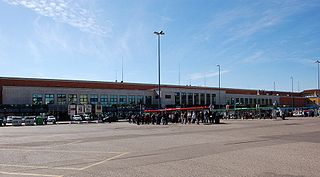
Verona Porta Nuova is the main railway station of Verona, Italy. It is one of the two stations serving central Verona; the other station, Verona Porta Vescovo, is located at the east of the city.

The Brenner Railway is a major line connecting the Austrian and Italian railways from Innsbruck to Verona, climbing up the Wipptal, passing over the Brenner Pass, descending down the Eisacktal to Bolzano/Bozen, then further down the Adige Valley to Rovereto/Rofreit, and along the section of the Adige Valley, called in Italian the “Vallagarina”, to Verona. This railway line is part of the Line 1 of Trans-European Transport Networks (TEN-T). It is considered a "fundamental" line by the state railways Ferrovie dello Stato (FS).

The Berlin–Palermo railway axis is project No. 1 of the Trans-European high-speed rail network (TEN-R), which involves the creation of a 2,200-kilometre-long (1,400 mi) high-speed rail line between Berlin and Palermo. It is designated as one of the main transport links connecting Central and Southern Europe, tracking through Germany, Austria and Italy.

The Tyrol S-Bahn, operated by ÖBB, provides regional rail services in metropolitan Innsbruck, Austria and its hinterlands in the state of Tyrol; and extended rail services into Italy and Germany.

The New Lower Inn Valley railway is a partially completed double-track high-speed main line of the Austrian railways. It connects the Brenner railway at Innsbruck and the Innsbruck bypass with the line to Kufstein, connecting with Germany, Salzburg, and eastern Austria. It forms a part of the core of the network of Austrian Federal Railways (ÖBB). The bypass is part of Line 1 of the Trans-European Transport Networks (TEN-T). The first section (Kundl–Baumkirchen), which is designed for speeds up to 220 km/h (140 mph), was opened on 26 November 2012. Since the timetable change on 9 December 2012, it relieves the existing Lower Inn Valley railway between Wörgl and Baumkirchen with trains able to operate at up to 250 km/h (160 mph). In the future, these and other construction projects are expected to reduce travel time on the Munich–Innsbruck route from 1:50 to 0:55 and on the Munich–Verona route from 5:20 to 2:20. The cost of the project amounted to €2.358 billion.

Wörgl Hauptbahnhof is the main railway station of Wörgl, a city in the Kufstein district of the Austrian federal state of Tyrol, about 20 km from the state border with Bavaria. It is a major hub for regional and international rail travel, both passenger and freight.

Bolzano/Bozen railway station is the main station of Bolzano/Bozen, capital of the autonomous province of Alto Adige/Südtirol, in northeastern Italy.

Trento railway station is the main station of Trento, capital of the autonomous province of Trentino, in northeastern Italy.

Rovereto railway station serves the Comune of Rovereto in the autonomous province of Trentino, northeastern Italy.

Brenner railway station is the border station of Italy and Austria. It serves the town and comune of Brenner in the autonomous province of South Tyrol, northeastern Italy.
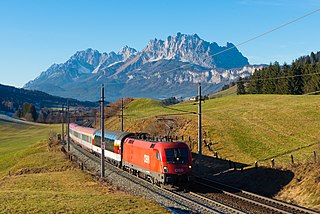
The Salzburg-Tyrol Railway is a main line railway in Austria. It runs through the states of Salzburg and Tyrol from the city of Salzburg to Wörgl and belongs to the core network (Kernnetz) of the Austrian Federal Railways (ÖBB). The section between Salzburg and Schwarzach-Sankt Veit is part of the Salzburg S-Bahn urban railway network.

Kufstein railway station serves the city of Kufstein, in the Kufstein district of the Austrian federal state of Tyrol. Opened in 1876, it is an Austrian-German border station, close to the border between Tyrol and Bavaria.

Tyrol is a historical region in the Alps of Northern Italy and western Austria. The area was historically the core of the County of Tyrol, part of the Holy Roman Empire, Austrian Empire and Austria-Hungary, from its formation in the 12th century until 1919. In 1919, following World War I and the dissolution of Austria-Hungary, it was divided into two modern administrative parts through the Treaty of Saint-Germain-en-Laye:

The Transalpin is a EuroCity express train linking Zürich (Switzerland) with Graz (Austria) via Liechtenstein. Introduced in 2013, it is operated by the Austrian Federal Railways (ÖBB) and the Swiss Federal Railways (SBB-CFF-FFS). From 1958 to 2010 a train of the same name linked Basel or Zürich with Vienna.


